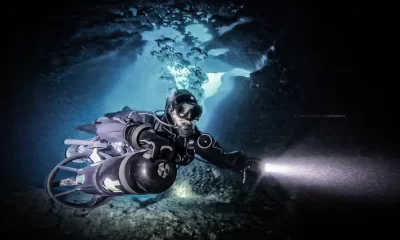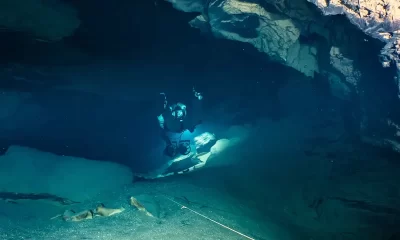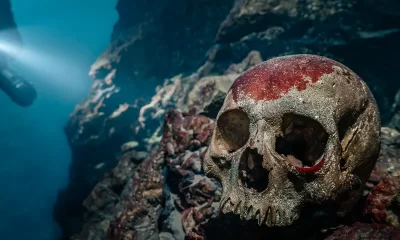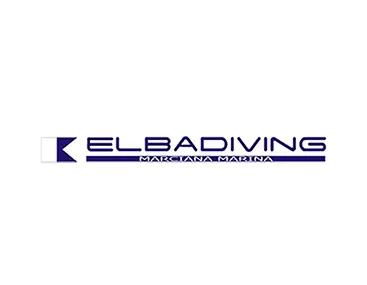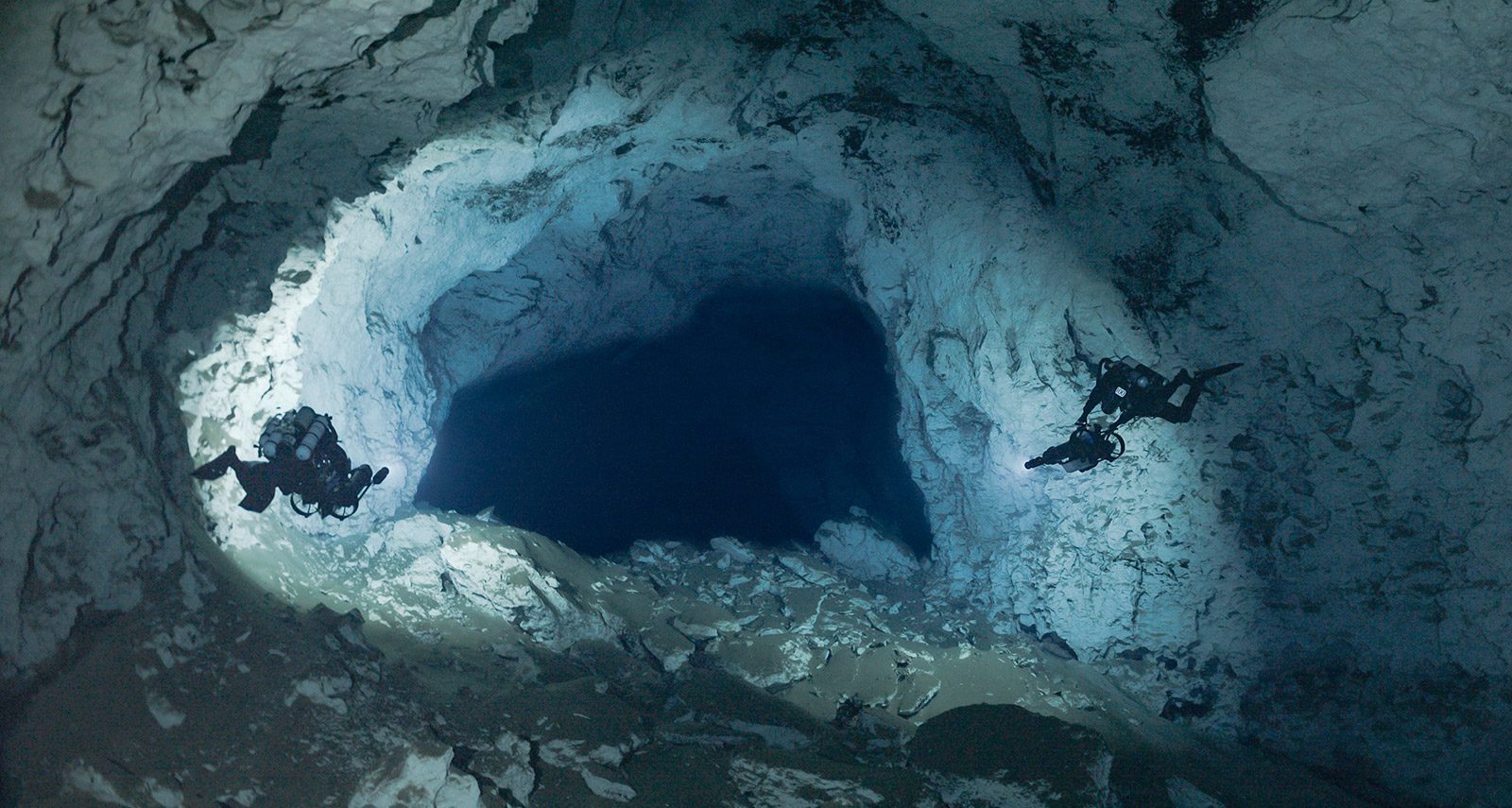
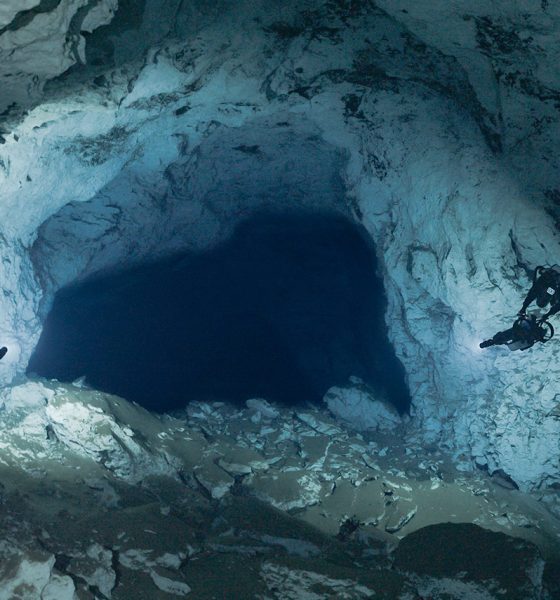
Cave
The First Helium-based Mix Dives Conducted by Pre-Tech Explorers (1967-1988)
More than 20 years before the emergence of technical diving, a handful of intrepid cave divers who were perilously pushing the limits of air diving, began experimenting with helium mixes for deep diving. Some succeeded, several were injured, one drowned.
By Dr. Christopher Werner. Header image: WKPP at Upstream Sullivan Sink by C. Werner.
🎶🎶 Predive Clicklist: 2001: A Space Odyssey Theme Song
More than 20 years before the emergence of technical diving, a handful of intrepid cave divers who were perilously pushing the limits of air diving, began experimenting with helium mixes for deep diving. Some succeeded, several were injured, one almost drowned. Though some of their tales are known, no one had produced a definitive chronology until WKPP board member and explorer Chris Werner set the record straight. Here, for the first time, are the origins of the “mixed gas,” aka “technical diving revolution” that irrevocably altered the course of sport diving.
As we wrote the initial script for our documentary describing the exploration efforts within the Woodville Karst Plain region of North Florida, End of the Line (See Trailer below), we discovered that there were many efforts by multiple explorers to use gasses other than air for deep cave exploration. I had thought this part of the story was well known and relatively free of ambiguity. However, the more I investigated it, the more assumptions and intrigue I unearthed.
Technical diving is full of harrowing discovery narratives—especially in the development and first uses of new technologies, their implementation, their subsequent evolution, and their use by explorers. But, by my estimation, many of these stories (even well-known ones) were filled with somewhat tall tales. Some stories have been passed along from diver to diver, descending more into myth than documented history. And, like all good stories, the facts and the tall tales were not always clear-cut.
Many of the stories in the Woodville Karst Plain area are quite exciting and make up a very important piece of underwater cave exploration history. But, as I found, the “history” was written by those that spoke the loudest. For me, it was more important to compile the most factual chronology I possibly could than it was to just recant the most sensational or convenient tales. More importantly, I strove to explore why these exploration efforts had spurred so many of the innovations that we take for granted now.

The truth is usually much more interesting than the spin, even though the tall tales are the ones that seem to propagate endlessly on the internet and in social media. But, it seems that many of today’s young technical divers—with exploration aspirations of their own—simply did not have a clue how or why we use “standard” equipment and techniques of today. The lack of context and appreciation for those that came before them, while not wholly unexpected, motivated my storytelling.
All of this led me to reach out to those involved in the Woodville Karst Plain exploration by several groups during the 1970s and 80s—the divers on the front lines of new equipment, technology, and technique developments. It quickly became clear that many of the things I thought I knew were a lot more nuanced than I had believed earlier in my diving career, each explorer equipped with their own interpretation.
Early thinking about redundancy, progressive penetrations, and gas management both shaped the common practices during that time period and influenced the exploration efforts of today. These past considerations influenced equipment development, configurations, technological innovations (like the manifold, lights, and DPVs), the techniques used for safe cave diving, and the mindsets of the individuals involved. It was clear there were good and bad trials on almost all fronts for a single objective: to go deeper and further into caves than previous explorers. And, in many cases, the costs were high and impactful.
I also discovered that the exploration efforts in the Woodville Karst Plain were intertwined with events elsewhere in the dive community, forming a complex feedback loop of trials and errors. Not all of these events received a lot of attention, but nonetheless had a great impact in the thinking of later explorers.
Examples of this could well be the fateful dives of Frank Martz on September 4, 1971 in the Bahamas Blue Holes #4, the Dana Turner dive on September 1, 1974 in Numero Uno in Florida (now known as Sally Ward), or the unsuccessful use of enriched air nitrox (26%) for eliminating narcosis by Court Smith and Lewis Holtzendorff in Little Dismal sink to a depth of 66 m/215 ft on June 1, 1975. Each of these rendered other gasses—such as oxygen and helium—“voodoo” mixes—and when they were used successfully, many in the community wrote them off as flukes.
This inevitably brought me to the development of helium-based mixtures for safely probing the depths that had previously been unattainable by civilian explorers using air. The development of helium-based mixtures for diving were well researched in military and commercial industries, and the US Navy had published Heliox tables in its manual as far back as the 1930s. So, let’s take a trip back and look at what I believe to be a nearly-complete record of the attempts to use helium as part of a heliox or trimix for deeper dives by civilian explorers.
The First Use of Trimix
My research into the early use of helium included conversations with numerous earlier explorers and rereads of several books and articles. I sought references, referrals, and materials from everyone I spoke with, and all of these were necessary for me to understand the totality of the subject and, more importantly, the nuances that shaped the thinking of the day.
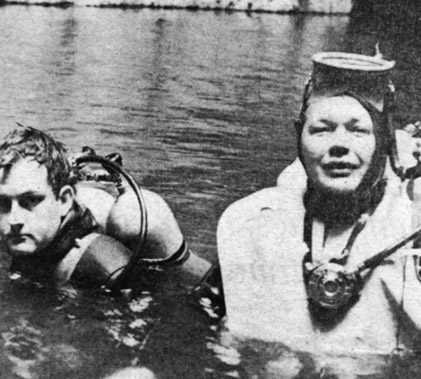
The story begins with a group of British SubAqua Club (BSAC) divers in the Silent Pool in Sinoia (Chinhoyi Caves), Rhodesia (now Zimbabwe). Ian Robertson of the Rhodesia Sinoia BSAC club, Roly Nyman, John and Danny van der Walt of the Normalair Club of Johannesburg dove on December 27, 1967, to 83 m/272 ft, reaching the sloping bottom of this giant cavern while using air. All four men experienced severe narcosis but had a successful dive.
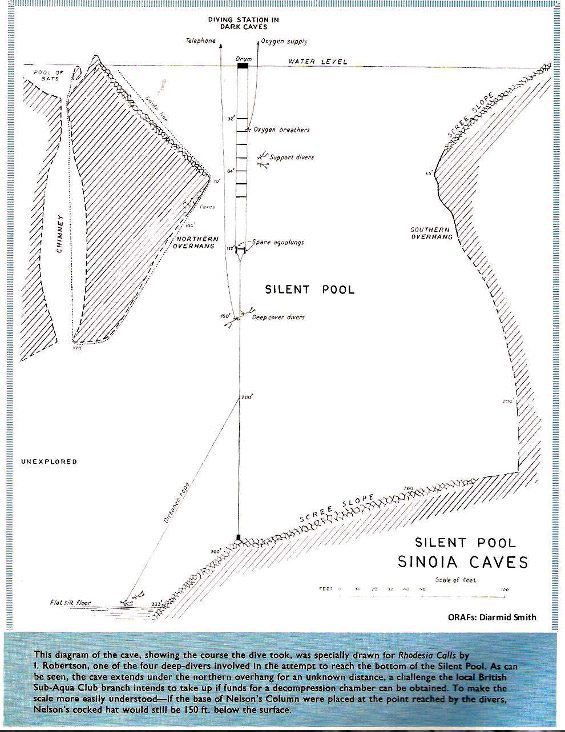
A short time later, a proposal was sent to Robertson from Nyman proposing a cooperative dive to the bottom of the sink in late 1968. The plan included the use of trimix—16% O2, 36% He and 48% N2 (trimix 16/36)—and the US Navy Diving Manual Heliox Tables. The Normalair Club would bring a small recompression chamber and the tanks of special mix. The Sinoia BSAC club had to supply a doctor, support divers and oxygen for decompression. It was an audacious but well-conceived plan and, according to Robertson, there were considerable risks.
On December 29, 1968, all four men entered the water in two teams. Nyman and Robertson descended to 86 m/279 ft depth and found a rocky slope. They used surface supplied lights with cables strung down a well-designed shot line in which they also staged their decompression bottles. Danny van der Walt experienced a regulator malfunction at ~75 m/246 ft, aborted the dive, and ascended with his brother to complete decompression. Nyman and Robertson descended to 90 m/295 ft, where they still observed the rocky slope continuing downward. They ascended to start their decompression using air and oxygen for decompression.
On December 30, 1968, the van der Walt brothers—having essentially full twin tanks—dove to 104 m/304 ft [PO2=1.76!], where the slope flattened out onto a silty, flat bottom as far as they could observe with the lights to ~6 m/20 ft distance. They then ascended. All teams used air decompression from 37-15 m/122—48 ft and then used oxygen on the 12 m/40 ft and 9 m/30 ft stops. They alternated 9 minutes on O2 and 1 minute on air for the entirety of the shallow stops. The teams had no signs or symptoms of decompression illness following the dives. They had a full support crew of 24 persons and a recompression chamber on site—quite a feat for an amateur diving club. It was the first civilian use of trimix we have on record.
Early Mix Try Dives – What Could Go Wrong?
The next attempt at civilian helium use was by Hal Watts in Mystery Sink outside of Winter Park, Florida in the United States. During operations the prior day, a diver was lost and presumed dead while diving on air in the deep sink. Watts was given a 16/84 mixture of heliox and appropriate decompression tables by the US Navy at the behest of the Governor of the State of Florida. In conducting the 108 m/355 ft dive, he recovered the deceased diver’s body successfully but got severely bent in the process. He ended up taking chamber rides over the next several days. This, in turn, led him to pursue “deep air” training, and the event added to the mystery of helium for use in deeper diving.
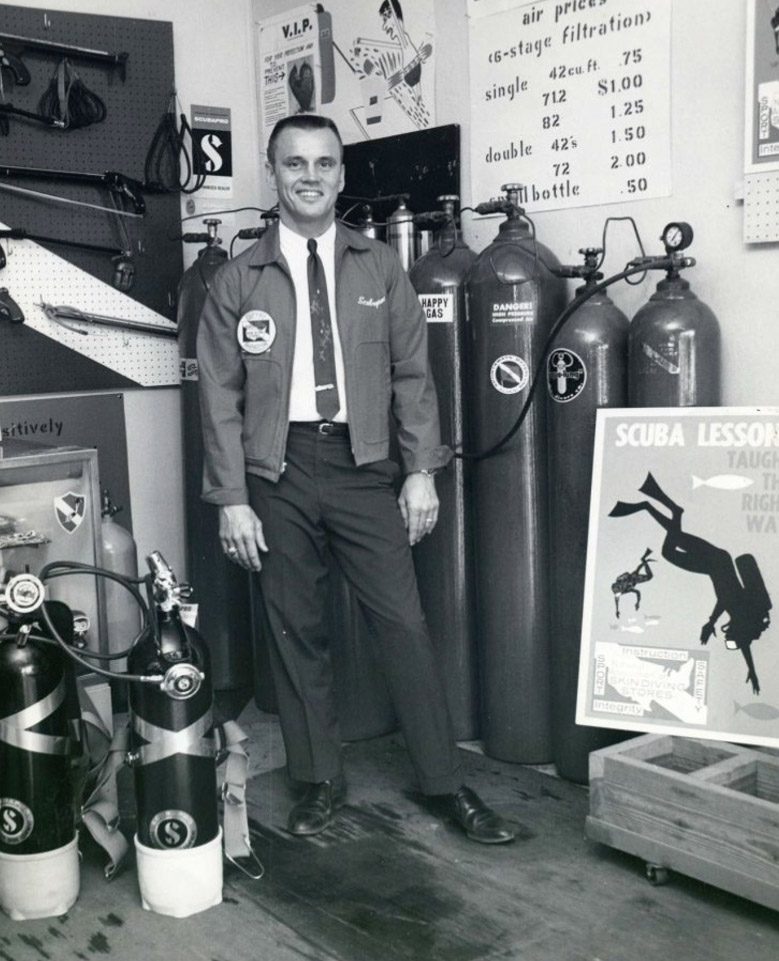
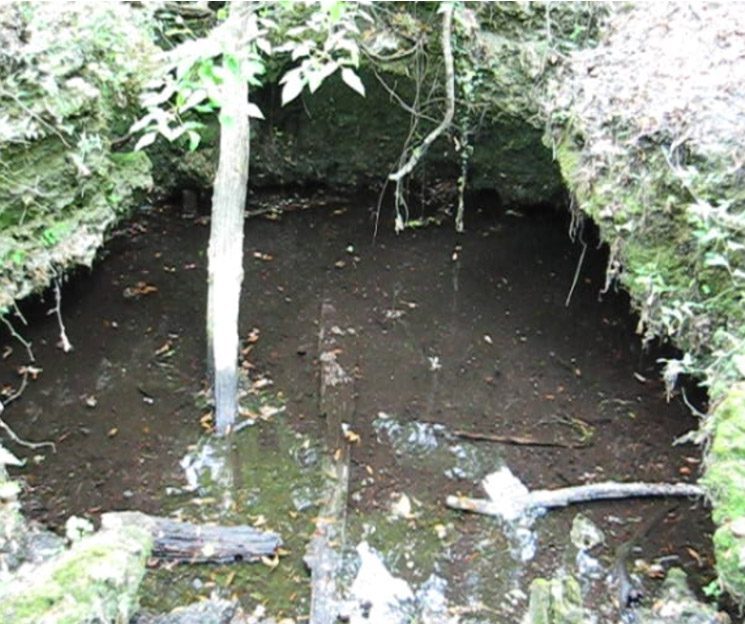
Both efforts were conducted in sinkholes but were essentially considered open water dives. In most instances, the case for using gasses other than air was for overcoming narcosis at much deeper depths. Even in the early trials, the most complicated issue was the decompression schedule. While the US Navy Heliox tables were available, they were not as thoroughly tested for many differing mixes and mandated oxygen starting at 12 m/40 ft depth—a partial pressure of oxygen (PO2) of 2.2!
In November 1975, Court Smith and Lewis Holtzendorff attempted a sneak dive in Wakulla Spring, Florida, on heliox 20/80. They penetrated approximately 335 m/1,100 ft, laying 76-91 m/250-300 ft of new line to a depth of ~77 m/250 ft. While on heliox, both got severely cold which accelerated their breathing rates, and it was only when they switched back to air at 34 m/110 ft that they began to warm back up and gain control of their breathing. They used the US Navy Heliox Tables and switched to pure oxygen at 12m /40 ft where they both convulsed after being on it for only a few minutes. Holtzendorff drowned nearly instantly. Smith somehow was able to dolphin kick to the surface where he was able to stop convulsing, and he miraculously survived the dive. He descended back down to 12 m/40 ft to finish his decompression and retrieve Holtzendorff’s body.
In 1978, Frank Fogarty and Roger Miller made a 100 m/325 ft deep dive in a Missouri sink known as Blue Spring. They, too, had experienced the hypothermia that Smith and Holtzendorff did, and both became severely hypothermic during the dive. There were no signs of the dreaded narcosis, but this dive confirmed there were other severe challenges.
UPDATE 10.24.22: A reader brought this to our attention. Thank you, Dave Sutton. In August 1968, the Oceanic Equipment Company, founded by Walter Starck, released the first commercially available electronic mixed-gas rebreather called the Electrolung. It was designed by Starck and John Kanwisher. Work had begun in early 1968 when the two were aboard Ed Link’s diving research vessel in the Bahamas. Production and sales were continued by Oceanic Equipment for two years and was then continued with further refinement of details by Beckman Instruments in Los Angeles (Electrolung: The First Mixed Gas Rebreather Was Available to Sport Divers in 1968 by Walter Starck). Within two years, the unit was being used with mixed-gas diluent for dives to 93m/300 ft. Typical mixed-gas diluent was 10% O2, 50% He, and 40% N2 (Paul J. Tzimoulis, Skin Diver Magazine, September 1970 and reprinted in Journal of Diving History, Fourth Quarter 2015, Volume 23, Number 85).
In September 1977, Dave Sutton used 20/80 Heliox in triple 65 cf. tanks with a 24 cf pony bottle of O2 to dive the oil wreck in the mud hole off the New Jersey coast at 51m/165 ft depth. He independently used the US Navy dive manual and partial pressure mixing to fill the tanks in a slight to his high school chemistry teacher who said it couldn’t be done. He did his initial dive shortly after he graduated high school and before attending Florida Institute of Technology without any assistance from others.
More Heliox Dives
Many of the things we know today about helium are now taken for granted. But, to get a glimpse of why divers were not using helium back in the day, consider the consensus of dives that had taken place. In the US, most people did not know about the successful Rhodesia dive. What they did know was that Watts had gotten bent on heliox, Holtzendorff had died using it in Wakulla, Smith had nearly died, and the Missouri crew had gotten severe hypothermia. For many, the use of gases other than air brought additional challenges in thermal management and decompression procedures.
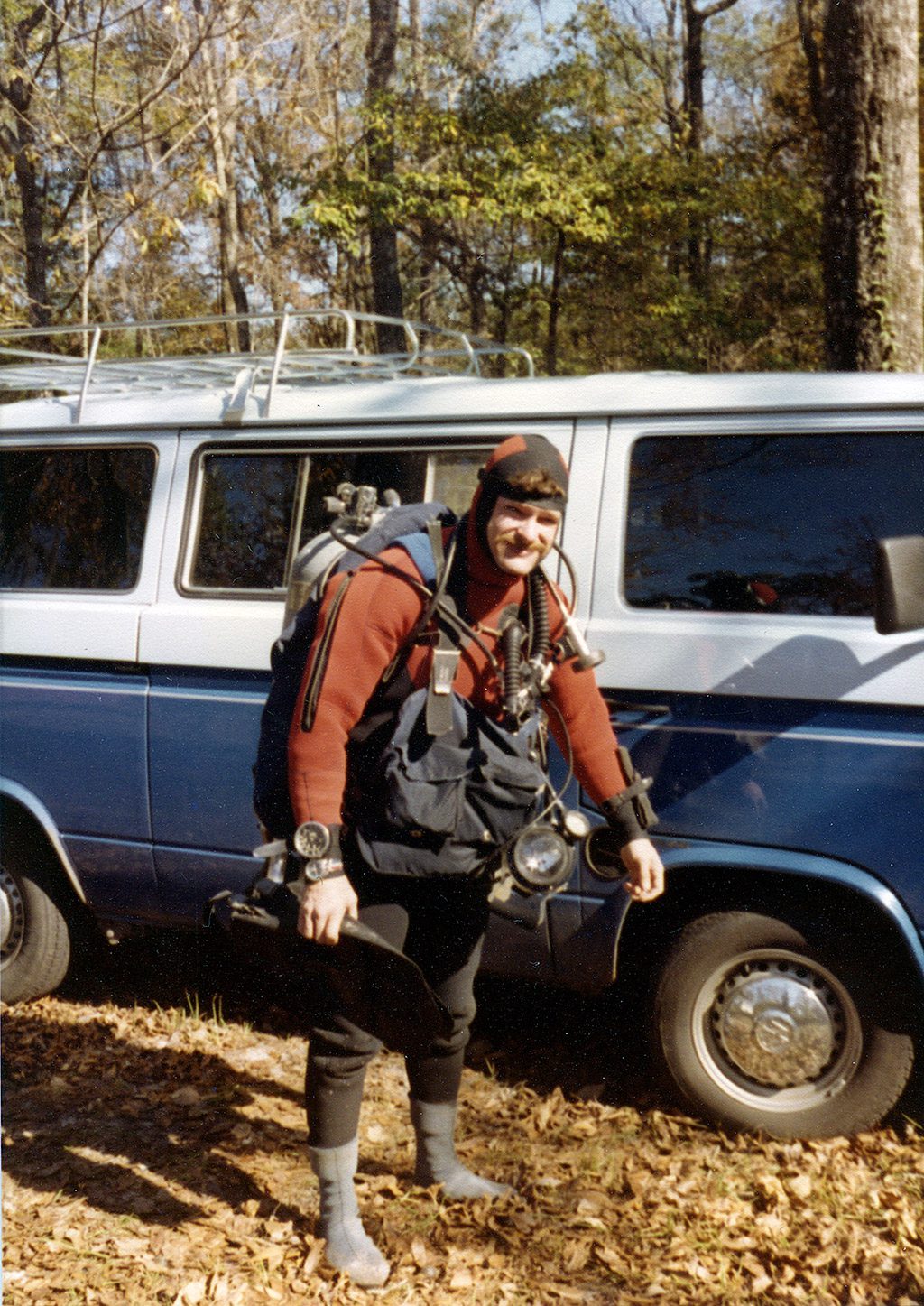
Sheck Exley had put it succinctly to then aquaCORPS Journal chief Michael Menduno in an email: “We were all looking and thinking, my god, what’s going on? You have to understand, the world depth record for cave diving was only 104 m/340 ft back in 1977, and it stayed that way until Sweet made his successful trimix dive at Diepolder 2 in 1980.”
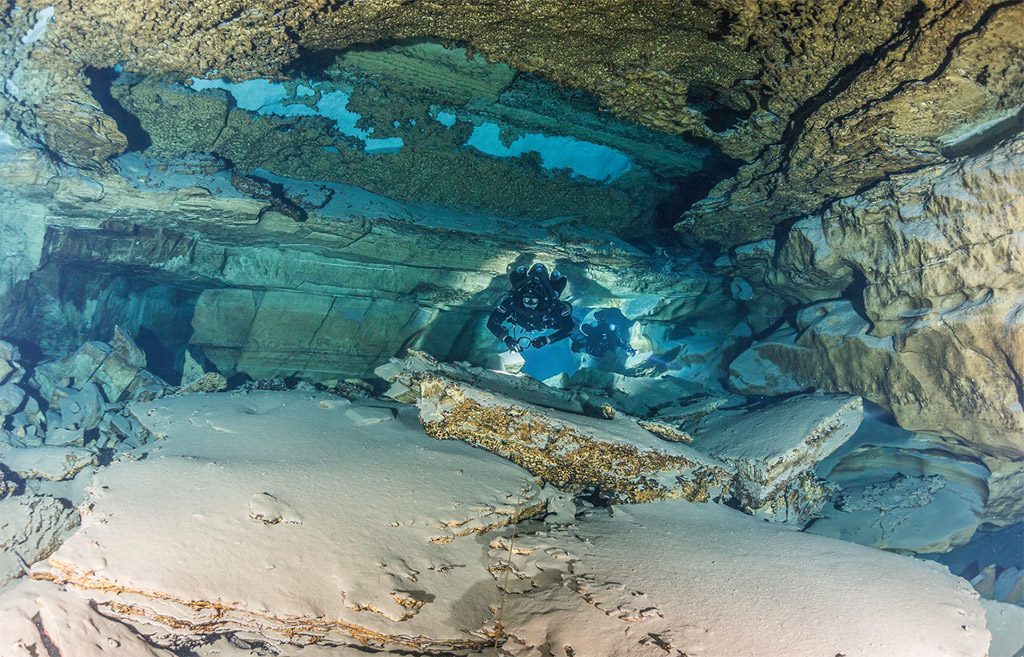
The surprising thing about the Dale Sweet dive in 1980 was not that he reached 110 m/360 ft in Diepolder 2, or that he set the new depth record, or that the decompression tables had worked and he surfaced unscathed from the dive, but that he was crazy even to try it. Up until this point, most folks in the diving community had thought of alternative gases other than air as voodoo. Prior dives only made divers more reluctant to even roll the dice. When I talked with Sweet, he stated that he didn’t have a choice but to use heliox. He wanted to see how deep this cave went, and it just wasn’t possible to safely do that on air.
This was very similar to the feedback I received when I spoke to Court Smith about his dive with Lewis Holtzendorff in Wakulla. They had both felt that they didn’t have a choice but to try it. What was clear is that there had been plenty of examples where diving deep on air, especially in a cave, had similar consequences.
The examples mentioned previously of Frank Martz and Dana Turner set the tone that is described well by Martyn Farr in The Darkness Beckons: “From the time of the Lewis Holtzendorff tragedy in 1975, opinion was very strongly opposed to the use of Trimix.” If the caves went deep, the options were limited: Take your risk with air and narcosis or use an experimental helium-based mix with a poor track record. It didn’t seem to be much of a choice and many explorers in the late 1970s and 80s didn’t really want to roll the dice.
The next developments in helium use would come from Europe in the early 1980s. At Fontaine de Vaucluse, France, Jochen Hasenmayer conducted a sneak dive days before Claude Touloumdjian on October 11, 1981. He descended to ~143 m/470 ft using a heliox mixture. This was a new world record for a scuba dive. Hasenmayer followed that dive up in 1983 in the same place, conducting a 205 m/672 ft heliox dive using modified Oceaneering tables. There are several depths noted from the record ranging from 201-210 m/656-685 ft, and the dive set a new world record.

In 1984, Oliver Isler used a trimix with 20% helium in Doux de Coly, France using DORIS (a French commercial diving company) tables. He modified them to use a 70% nitrox mix for the 12 m/40 ft and pure O2 on his 9 m/30 ft stop. The dive was successful and set a new penetration distance record.
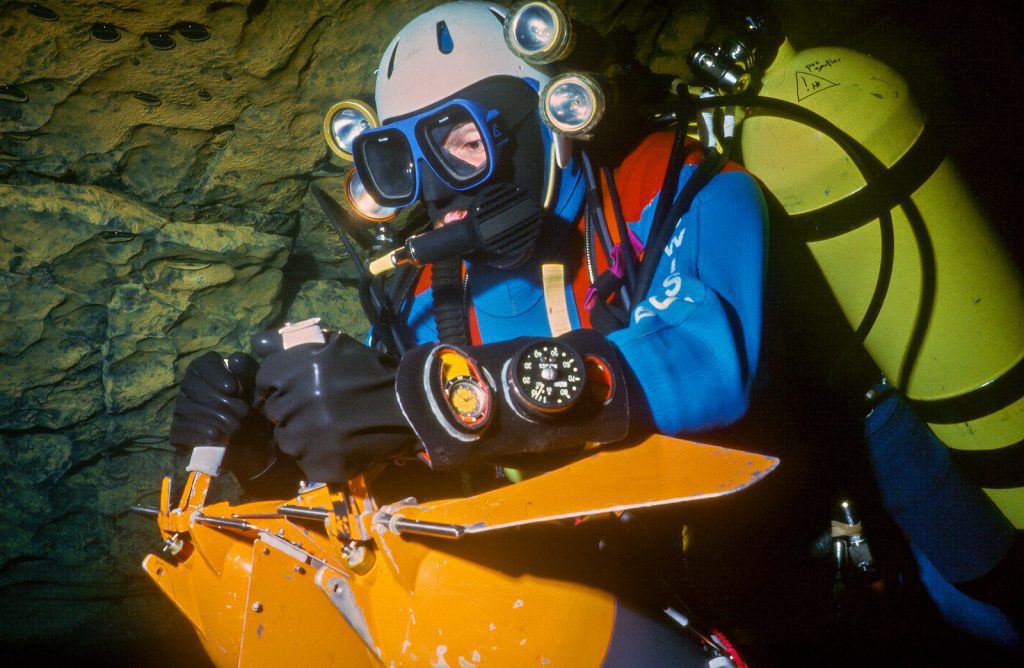
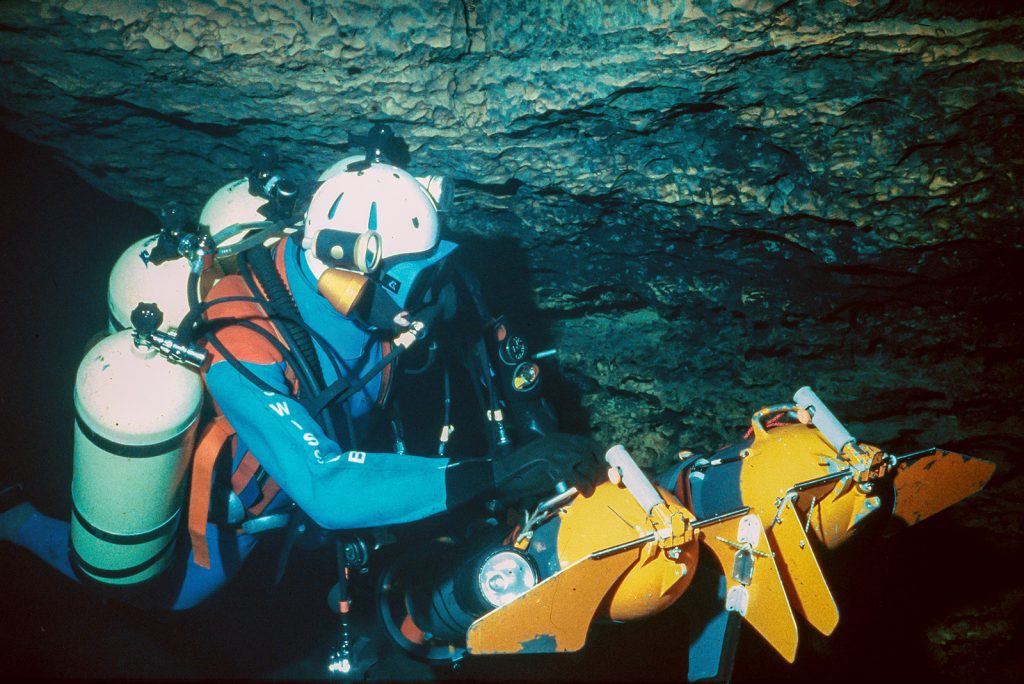
The only record I could find of other dives during the early 1980s occurred in the US Great Lakes when Jerry Buchanon, Bob Horton, and Joe Schneeweis conducted a series of open circuit heliox dives on the wreck of the Gunilda at a depth of 74 m/240 ft in Lake Superior, Michigan. There isn’t much detail on these dives, but it’s likely that due to the water temperature and the depth, the heliox helped eliminate narcosis in the cold water.
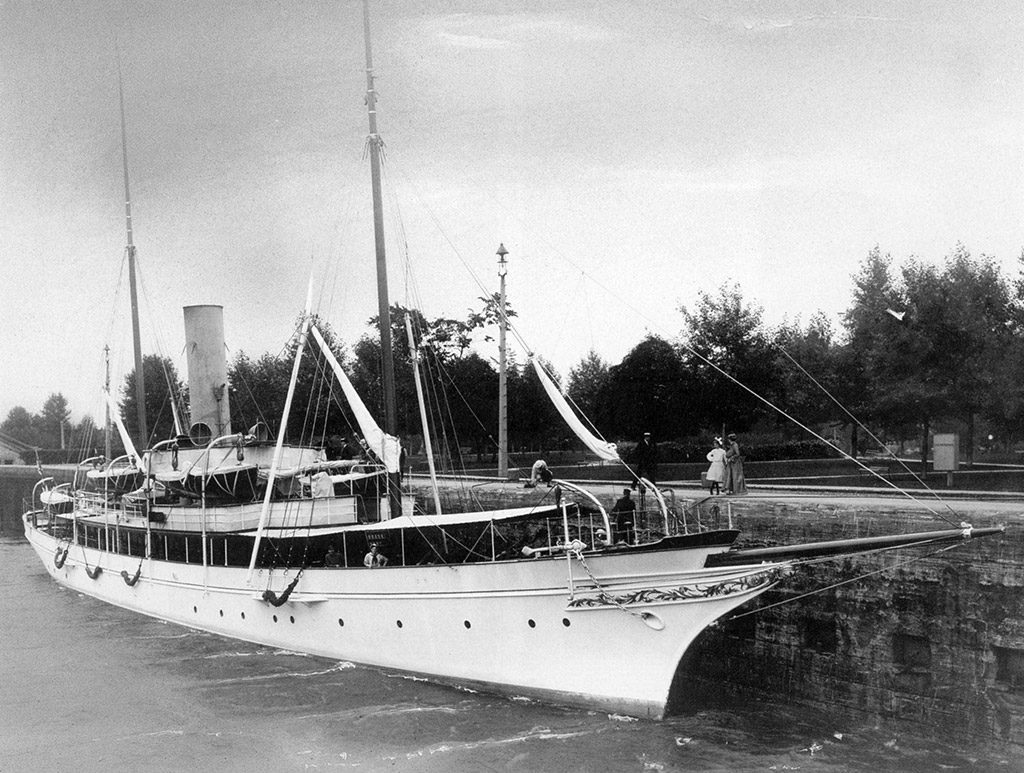
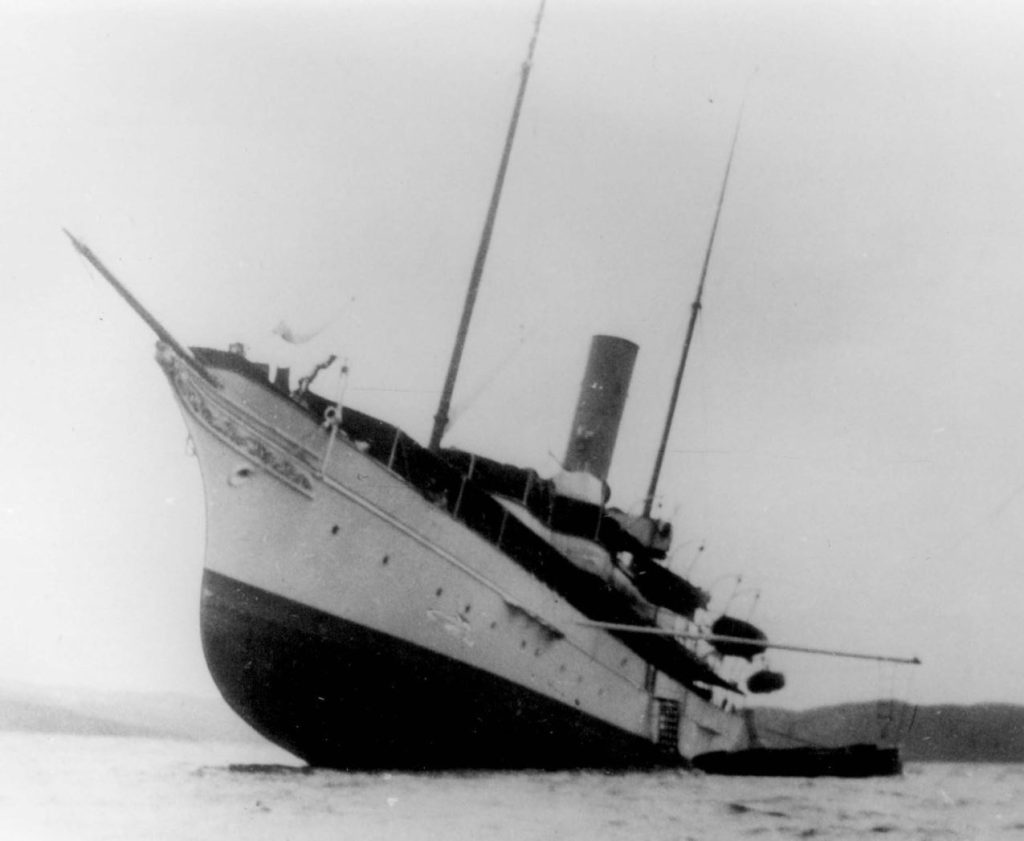
Sorting Out Mix Decompression
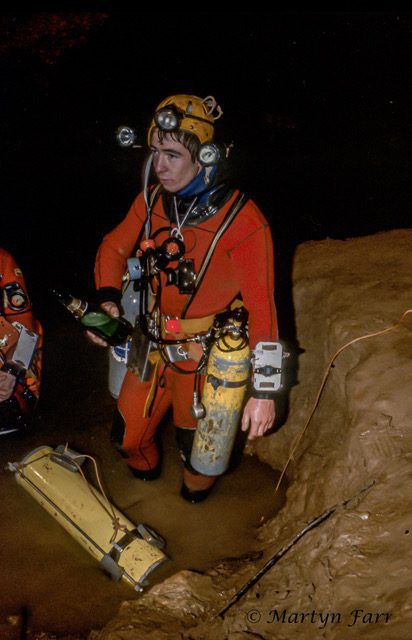
A turning point came in 1985 when Rob Parker and Bill Stone had Air Products in Jacksonville, Florida, mix up a trimix 20/25. They used it at Diepolder 2 as a rehearsal for a push beyond Chamber 25 in Wookey Hole, UK in July of 1985. Dr. John Zumrick had been running recent deep dive profiles at the Naval Experimental Diving Unit (NEDU) and observed (along with Capt. Edward Thalmann) that the decompression for helium breathing mixtures resembled the extended US Navy air decompression tables.
In a meeting at Wakulla Springs Lodge dining room in April 1985, Zumrick offered up the following advice to Stone and Parker: “Keep 20% O2 and start adding helium, and you should be able to use the extended air deco tables.” Stone also stated that Zumrick had recommended switching to O2 at the 9 m/30 ft stop and shallower.
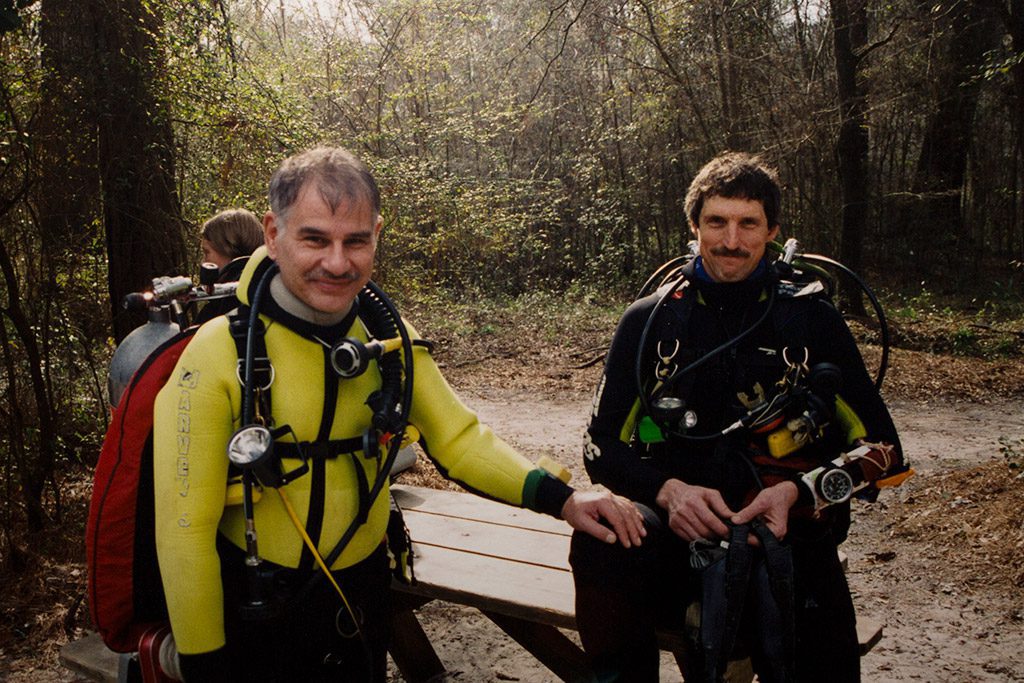
That is exactly how decompression schedules were used for the upcoming project in Wookey Hole and the Andros Project scheduled for Summer 1987. Stone recalls that the best part was that no one got bent. Later that summer, in July 1985, Rob Parker used trimix to push the sump of Chamber 25 in Wookey Hole to a depth of 68 m/223 ft diving trimix 19.5/36. Bill Stone mixed the gas for Rob, and Zumrick designed the decompression tables.
In 1986, Charles Maxwell organized a 30-person team to dive Dragon’s Breath in Namibia using trimix. Alain Vuagniaux and Christian Rufi dived to 90 m/295 ft utilizing four back-mounted 18-liter cylinders. These dives and decompression schedules were likely developed independently from the dives in Florida and the UK. Stone suggested that Maxwell’s team was probably aware of the previous trimix dives in Sinoia, Rhodesia in 1968, but likely unaware of the Stone, Parker, and Zumrick work at Diepolder 2 or the Wookey Hole dive in 1985.
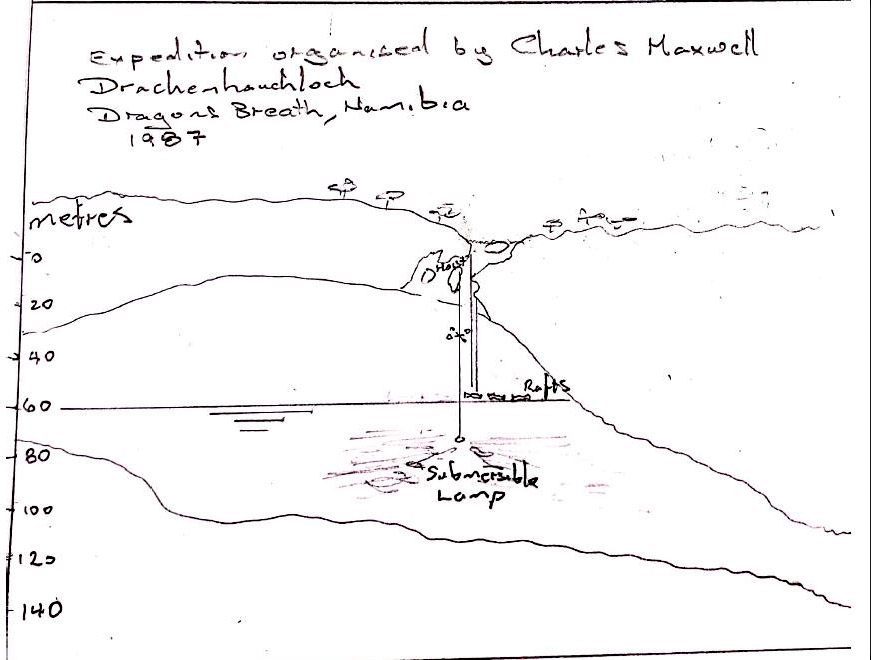
Exley, Palmer, and the WKPP Hit The Mix
After the advances by Dale Sweet and Jochen Hasenmayer in the early 1980s and the subsequent dives by Rob Parker and Bill Stone in 1985, Sheck Exley also began to contemplate switching to helium-based mixtures for his deep dives. On April 22, 1987, Exley dove in Nacimiento del Rio Mante, Mexico to a depth of 159 m/520 ft, establishing a new American record. The dive had a 15-minute bottom time and used a trimix 10/50 utilizing Buhlman/Keller tables. He experienced several possible symptoms of DCI and/or oxygen toxicity during the ascent. On June 23, 1987, Exley returned to Mante and extended his line to a depth of 202 m/660 ft, tying the depth record of Hasenmeyer in Vaucluse.
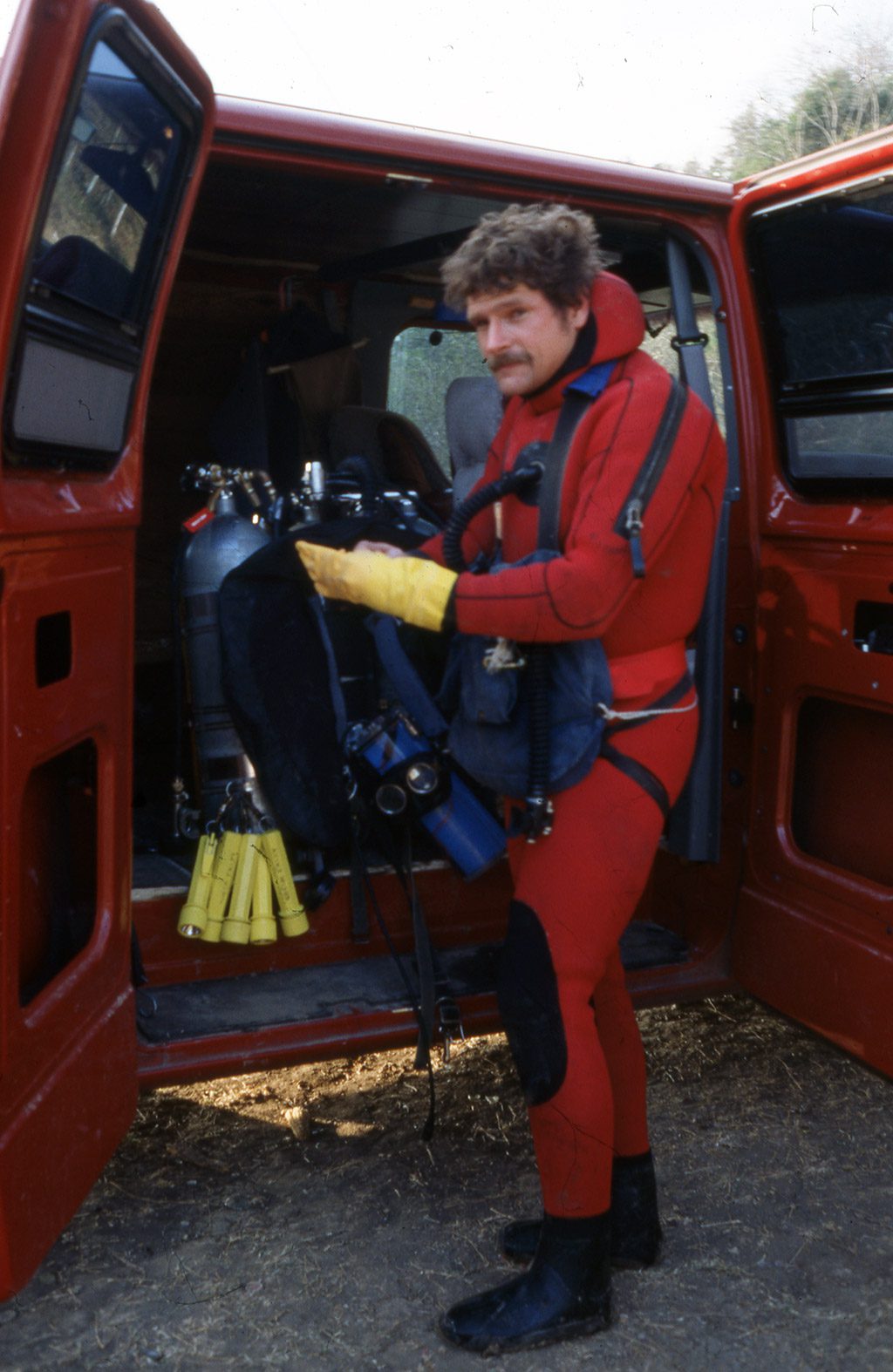
In July of 1987, the Andros Project in the Bahamas led by Rob Palmer commenced. Divers used a 20/80 heliox mix and Dr. RW Bill Hamilton’s DCAP tables, and at least one dive used standard US Navy tables. The project also used Carmellan rebreathers provided by proprietor Stuart Clough and open circuit dives. The team quickly realized that they could eliminate narcosis by using heliox. Since they were using rebreathers, it made even more sense to use the heliox, as it was in short supply. Rob Palmer, Bill Stone, Rob Parker, Stuart Clough, Neil Cave, and Richard Stevenson successfully completed about 10 heliox dives in Mars Bay Blue Hole, Stargate, El Dorado, and Sanctuary.

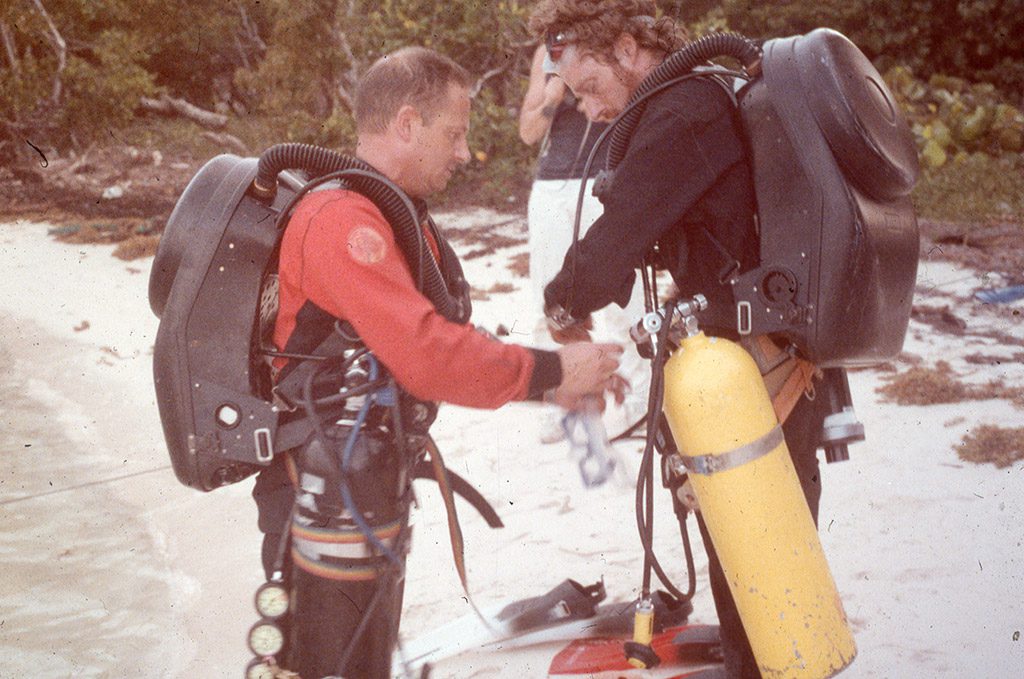
Andros Project divers didn’t experience any decompression incidents, proving that larger scale projects could be run with helium-based mixtures. This was the first large-scale use of heliox for a project, and these techniques were ported directly to the Wakulla Project which would begin later that year.
In an independent development, on August 22, 1987, Bill Gavin and Bill Main dove Sally Ward, Florida downstream with trimix using 550 psi of helium in their double 104’s topped with air to 3,600 psi. They pushed 46 m/150 ft into a big room with no real exit at 88 m/290 ft of depth. They used a separate air inflator bottle to fill the dry suit. Gavin designed the tables, interpolating the US Navy air tables and the Navy Heliox tables. On September 13, 1987, Main, Gavin, and Lamar English pushed upstream Sally Ward using trimix to an unstable breakdown area at the end of the Smith and Holtzendorff line. Both dives were successful, and the decompression tables worked.
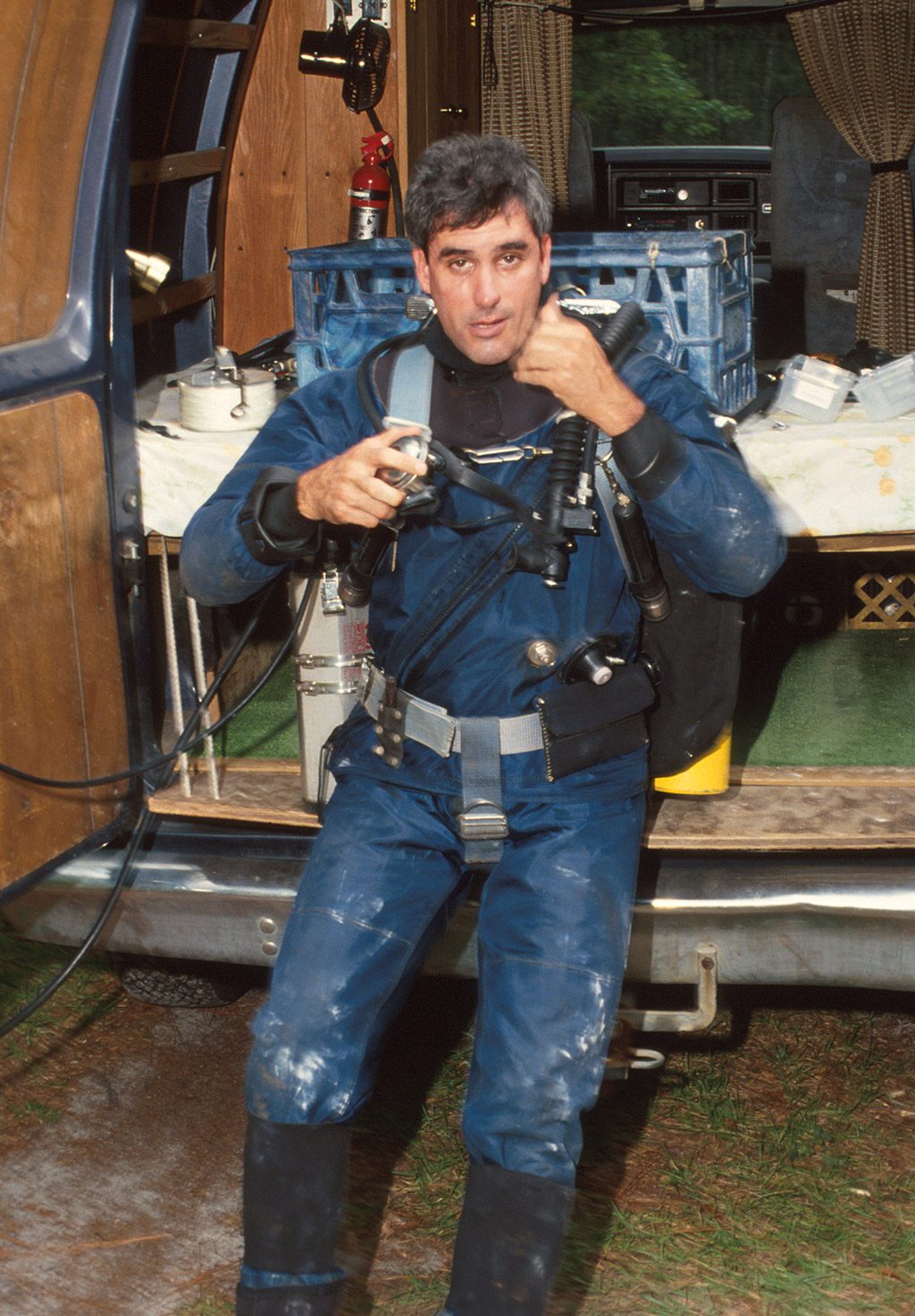
These dives were made with the knowledge of the Smith and Holtzendorff Wakulla dive and the Dale Sweet dive in Florida, but the fledgling Sullivan Sink divers (the predecessor to the WKPP) were unaware of the recent developments by Rob Parker, Bill Stone, and John Zumrick in 1985, the earlier European progress, and the Andros Project dives. They were aware of the Exley dive in Mante, as English had designed a deep canister light for Exley, but no mix or table information from those dives was available to them.
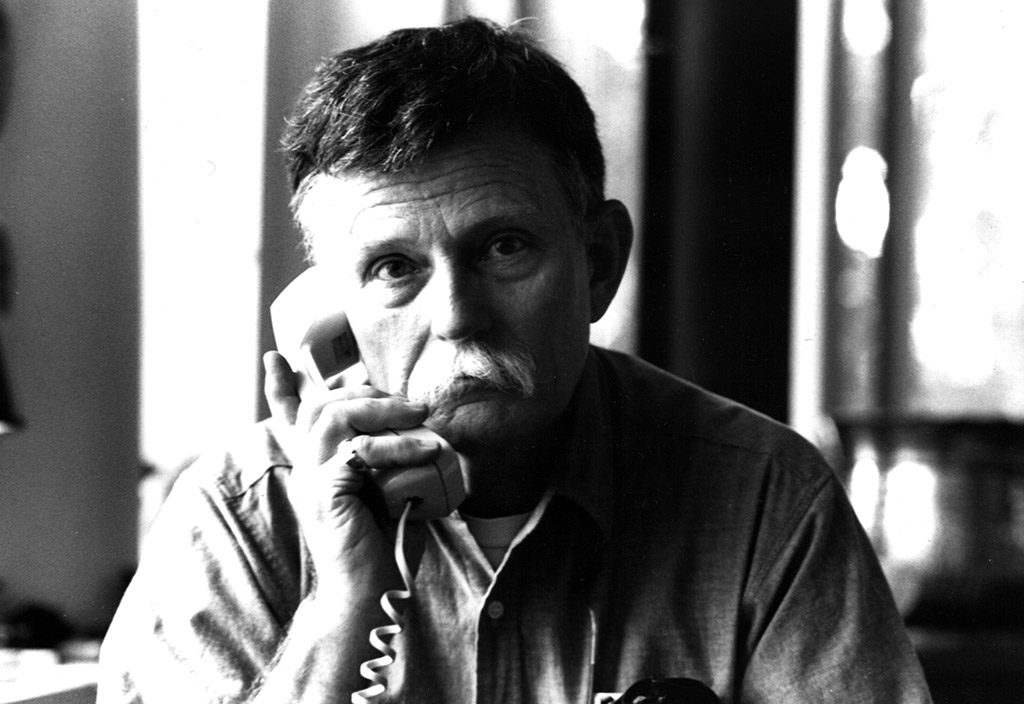
Another dive was conducted on September 27, 1987, by Main, Gavin, and English. The trio sneak dived Wakulla Springs using trimix before the Wakulla Project gained access. Following this dive, Parker Turner had reached out to Dr. Bill Hamilton to get advice on new tables prior to dive planning for pushes downstream in Sullivan Sink. On October 31, 1987, Gavin and Turner dove trimix 19/25 in downstream Sullivan staging four bottles downstream in preparation for their push dive past the current end of line. On November 5, 1987, Lamar English, Parker Turner, Bill Gavin, and Bill Main dove downstream Sullivan Sink using trimix 19/25, adding 226 m/740 ft of line at a depth of 67 m/220 ft. The dive was conducted using modified Tekna scooters, two stages per each diver, and four total safety bottles. On both dives, the Hamilton recommendation was to use nitrox for intermediate stops which significantly improved the decompression.
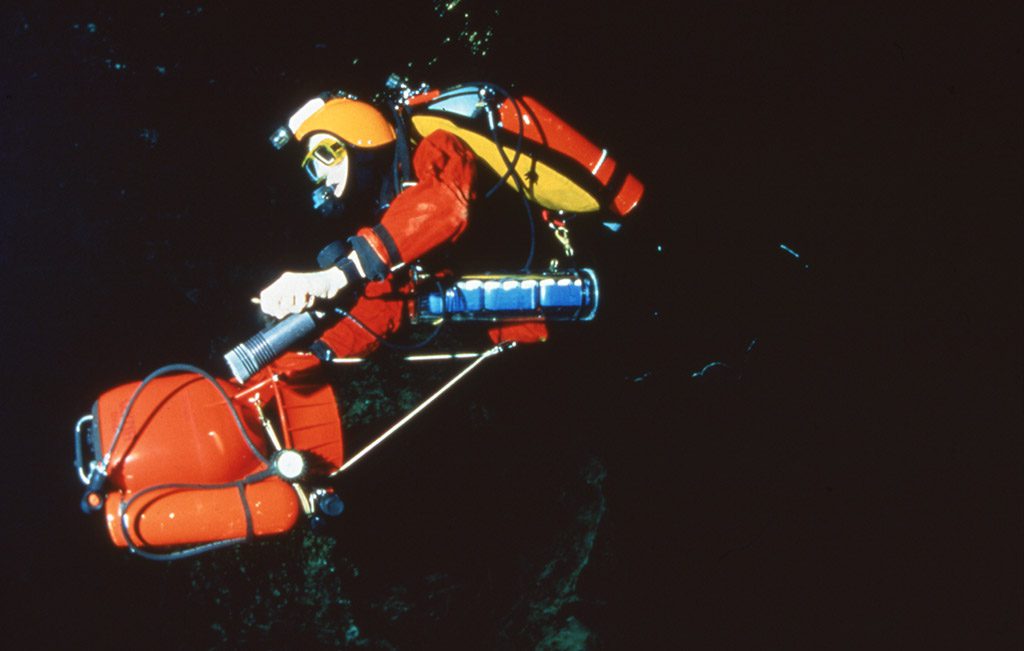
The Wakulla Springs Project
In late October in 1987, the Wakulla Project led by Dr. Bill Stone commenced at Wakulla Springs, Florida. The team was supplied with heliox 14/86 and limited quantities of heliox 10/90 in case it went deeper. They used Hamilton Research DCAP decompression profiles, using nitrox above 40 m/130 ft and eventually switching to O2 in the habitat. This was the first large-scale tech expedition and served as a template for future projects. Some have referred to it as the expedition that launched technical diving.
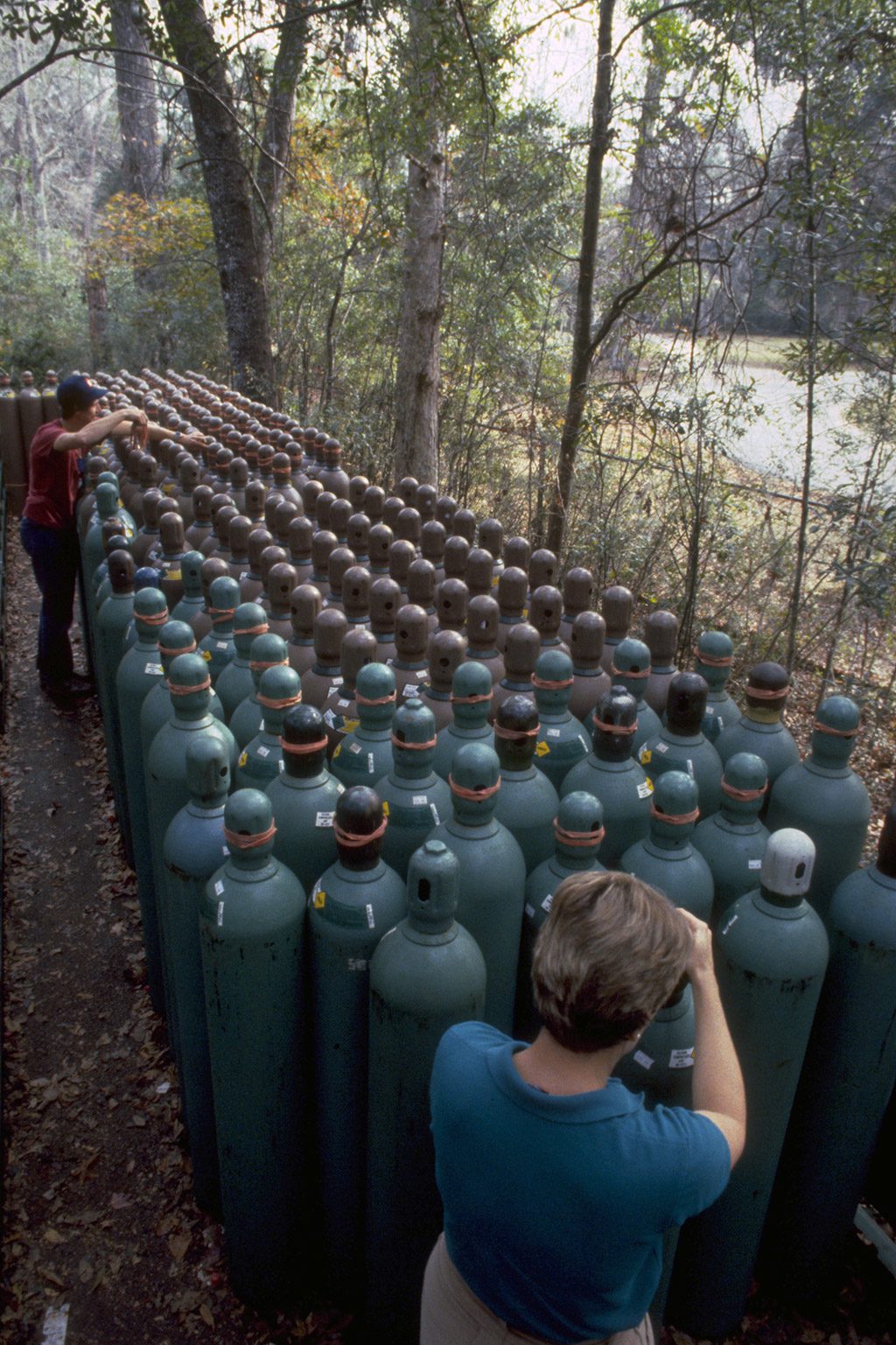
Stone estimated the teams were burning $1,100/diver/mission in helium using conventional open-circuit, and that was in 1987. It is important to note that Sheck Exley and Paul DeLoach did perform several dives on trimix, but following an AquaZepp failure in D-tunnel and having to swim out, they both switched over to the heliox mix to prevent running up against the higher PO2 limits.
The project had a specially-designed in-water decompression habitat where they could exit the water both for thermal reasons and safety reasons, given the depth, bottom times, and decompression times they experienced in exploring the many tunnels of the cave. Overall, there were more than 15 heliox exploration dives with considerable support, setup, and rigging dives totaling 162 total dive missions for the Project. The team explored 3,309 m/10,858 ft of new passages in Wakulla Spring and set the penetration at depth record of 1,272 m/4,176 ft in B-tunnel. They also engaged in scientific sampling, filming, and dye tracing.
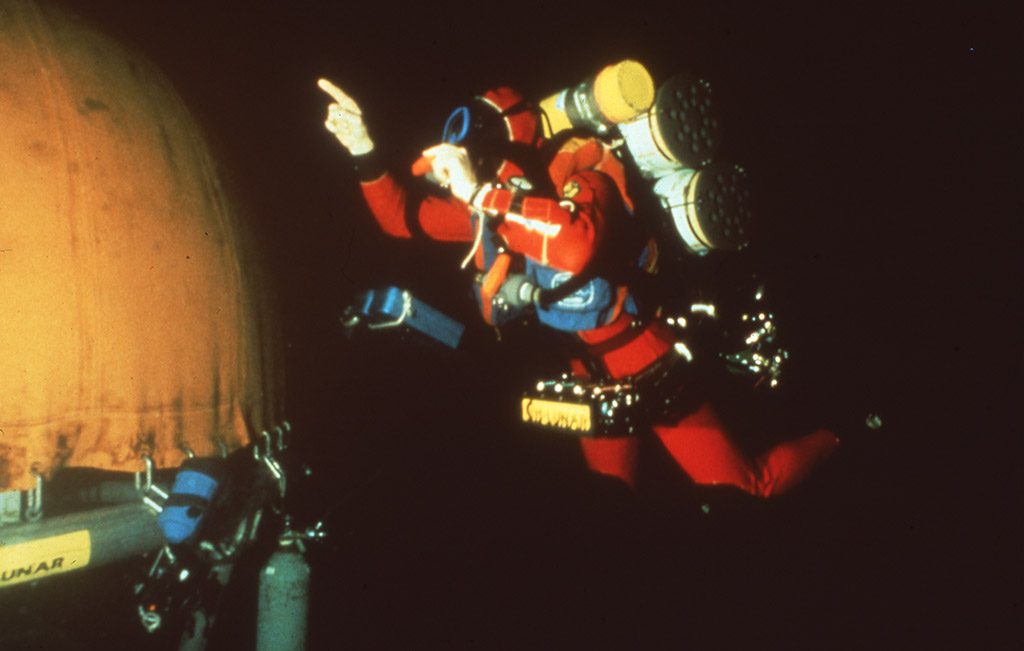
In addition, Stone used his prototype Cis-Lunar MK-1 closed-circuit rebreather (dubbed the “Failsafe Rebreather for Exploration Diving,” aka FRED) for eight dives in the basin; and used it to set a 24-hour submerged dive record on a rebreather on December 3-4, 1987, proving its utility.
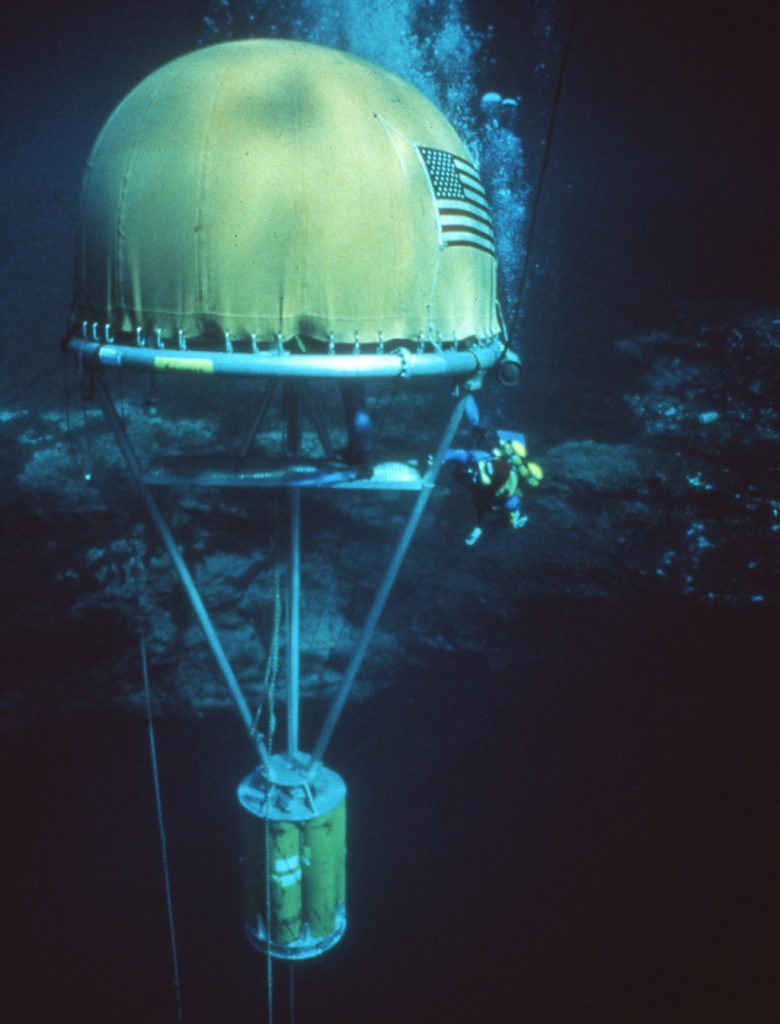
At the same time, the fledgling WKPP continued to explore downstream Sullivan Sink with progressive penetrations on November 14 and 21 using trimix. They moved to Cheryl Sink and began to push the upstream passage on December 12, 13 and 27. They continued into 1988 with dives on January 2, 3 and 9, which culminated in the connection between the sinks—all using trimix and Hamilton tables. Gavin, Turner, Main, and English performed the traverse from Sullivan to Cheryl Sink on June 18, 1988, setting a new world record traverse distance at 2,674 m/8,770 ft.
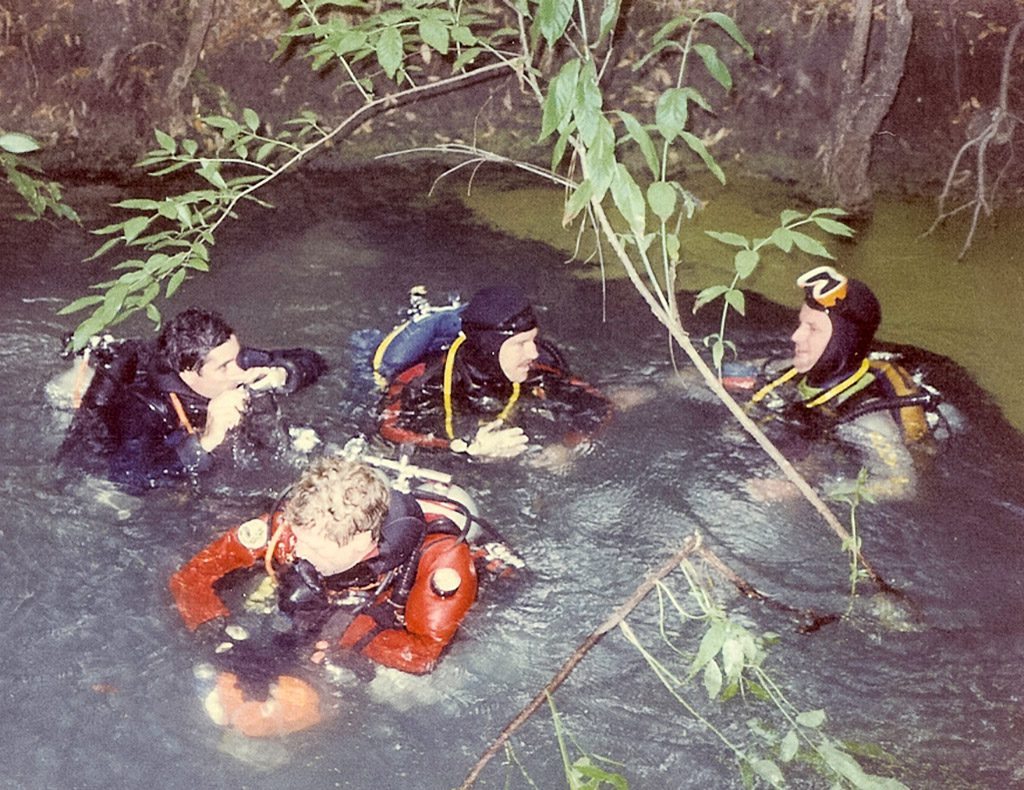
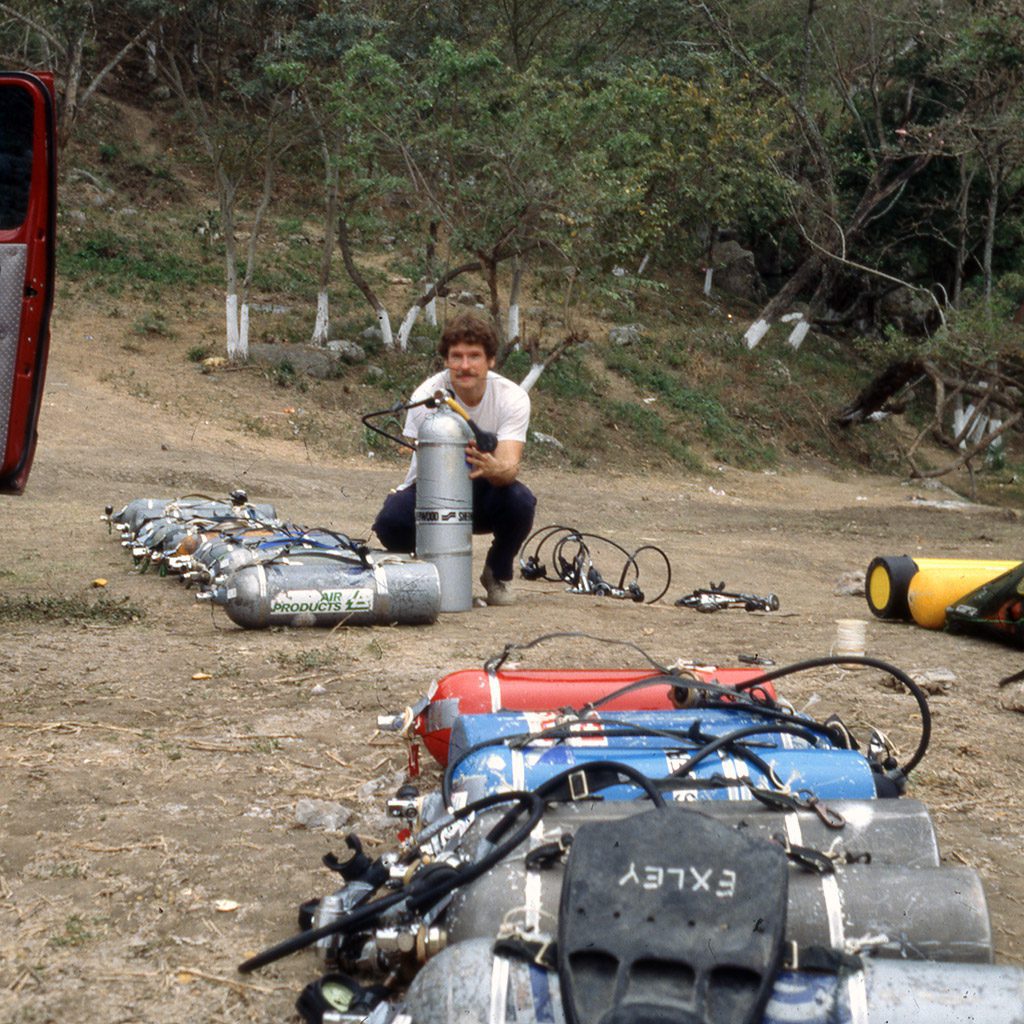
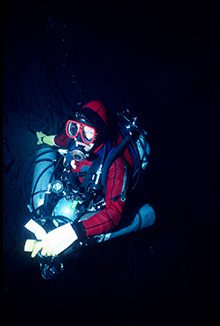
On April 5, 1988, Sheck Exley dove Mante, Mexico, to a depth of 238 m/780 ft, setting a new world record using trimix and Hamilton tables.
By the summer of 1988, helium-based mixed gas use was now the standard for longer and deeper dives over 61 m/200 ft and beyond. This ushered in a new paradigm shift in what was soon to be called technical diving, and it would next spread to deep wreck diving shortly thereafter.
References:
English, Lamar, 2022. Personal communication.
Exley, Sheck, 1987. New Depth Record in Mexico, NSS-CDS Underwater Speleology, v. 14 n. 5.
Exley, Sheck, 1988. Depth Records Broken, NSS-CDS Underwater Speleology, v. 15, n. 4.
Exley, Sheck. Logbook entries.
Exley, Sheck, 1994. Caverns Measureless to Man, Cave Books, 326 pp.
Farr, Martyn, 2017. The Darkness Beckons, The History and Development of world Cave Diving, 3rd ed., Vertebrate Publishing, Sheffield, 416 pp.
Gavin, Bill, 2021. Logbook entries.
Main, Bill, 2021. Personal communication.
Main, Bill, 2021. Logbook entries.
Menduno, Michael, 2022. Personal communication.
Palmer, Rob, 1989. Deep into Blue Holes: The Story of the Andros Project, Unwin Hyman, London, 176 pp.
Robertson, Ian. Diving the Sinoia Silent Pool – Chirorodziva.
Smith, Court, 2020. Personal communication.
Smith, Court, 2020. Logbook entries.
Stone, William C., 1993. The Wakulla Spring Project, USDCT, NSS, Huntsville, 212 pp.
Stone, William C., 2022. Personal communication.
Sweet, Dale, 2021. Personal communication.
Taylor, Larry. Diving with Gas Mixes Other than Air,
Wisenbaker, Michael, 2021. Personal communication.
Dive Deeper:
InDEPTH: The Early Days of Technical Trimix Diving (1992) by Michael Menduno and RW Bill Hamilton, including Key West Consortium Tables for the USS Wilkes-Barre from the aquaCORPS archives.
GUE.com: Exploration History Of The WKPP (1997) by Chris Werner
InDEPTH: Celebrating Sheck Exley Repost of Ned Deloach’s 1988 classic “THE DEEPEST DIVE: A Study in Controlled Paranoia.”
InDEPTH: A Page Out of History: Sheck Exley’s 1989 Mante Table (867 ft/265m)
InDEPTH: Tech Diving into Pop Culture (w/Olivier Isler)
InDEPTH: Dr. Bill Talks Mix RW Bill Hamilton and cave diver nurse anesthetist John Crea discuss “special mix” diving at the TEK.95 conference (1995).
InDEPTH: Check out Dr. Bill Hamilton’s perspective on the emergence of technical diving in his seminal 1990 article from the first issue of aquaCORPS aquaCORPS #1 UnderPressure, “Call It High Tech Diving.”
InDEPTH: Thoughts on Diving To Great Depths (1998) by Jim Bowden
Divernet: THE TECHNICAL DIVING REVOLUTION-PART 1 by Michael Menduno
Divernet: THE TECHNICAL DIVING REVOLUTION-PART 2 by Michael Menduno
Divernet: THE TECHNICAL DIVING REVOLUTION-PART 3 by Michael Menduno
InDEPTH: The Santa Barbara Helium Rush—The Legacy Of Dan Wilson’s 400-foot Gas Dive By Don Barthelmess. These were the first commercial helium-based mixed gas dives conducted in 1962 offshore from Santa Barbara, California.
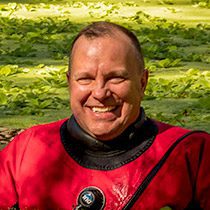
Dr. Christopher Werner is President of Praeter Saepe, a media creation and content provider documenting exploration efforts. He serves as the Science Director and Board Member for the WKPP, positions he has held since 1998 and 1995, respectively. He has been scuba diving since 1989 and has logged over 2,500 total dives, with more than 1,750 in underwater caves, 1,900 using mixed-gasses, 1,700 involving decompression, and 850 deep exceptional-exposure decompression profiles.



















